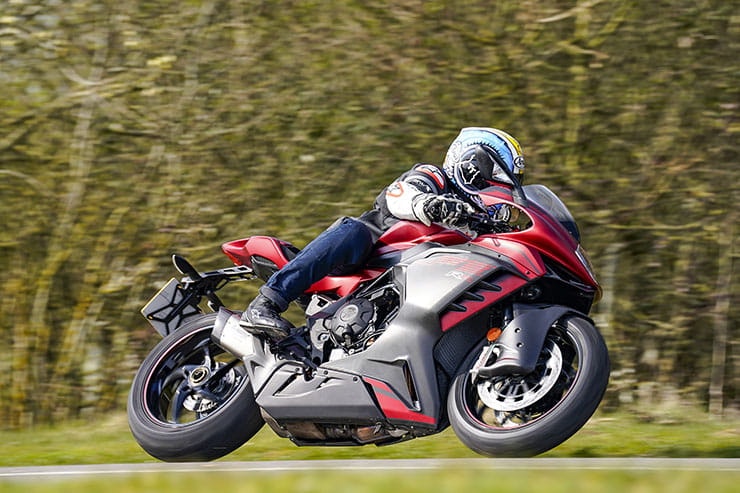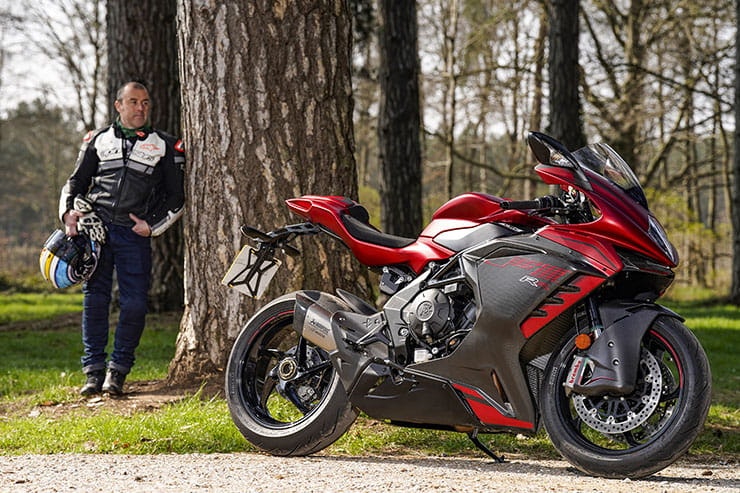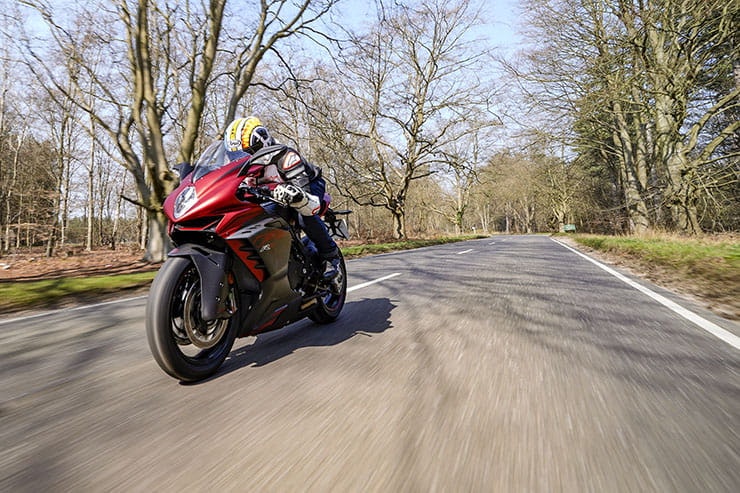MV Agusta F3RR (2022) - Review
BikeSocial Road Tester
25.04.2022
Price: £19,660 | Power: 145bhp | Weight: 173kg (dry) | Overall BikeSocial rating: 4.5/5
Just a decade ago if you didn’t want a 1000cc superbike for the road you still had a plethora of exciting bikes to choose from: multiple 600cc machines, a 675 from Triumph and MV, a 636 from Kawasaki and, if you turn back the clocks further still, bikes like Suzuki GSX-R750 or even Kawasaki’s ZX-7R. These apex-hunting middleweights are now as rare as an honest politician.
MV Agusta is almost the last man standing, and not only still producing the F3 800cc triple but doing so in two options, the Rosso and the exciting RR which we have on test. Yamaha’s R6 is available as a track-only option, and Ducati still produces the twin-cylinder Panigale V2, which is competing in World Supersport alongside MV with its F3.
To keep producing the MV F3RR, the Italians have had to make some amendments to meet Euro-5. They have done this with a host of engine changes which have kept power at a quoted 145bhp from the 798cc triple – same as the standard Rosso version.
The most dramatic and obvious update is the new aerodynamic package, which is designed to generate downforce and is a first in this middleweight category. The new RR features attractive enclosed wings, not too dissimilar to those found on the new Fireblade. According to MV, these clever little ‘appendages’ add 8kg of downforce at 240kph/149mph. There’s also a taller screen and a very trick Moto 2 style front hugger that wraps around the fork legs.
Not so obvious is the 10% lighter rear wheel, which reduces inertia by 7%. There’s a new seat with a grippier surface, and new CNC machined pegs. Those with a keen eye will have noticed this isn’t a standard RR… MV fitted our bike with the race kit, which includes a CNC machined fuel cap and levers, plus a pillion seat cover, while the Akrapovič exhaust will attract the most admirers. The race kit with ECU boosts power by 8bhp and chops 8kg from the total weight, bringing it down to just a quoted 165kg (dry).
We spent a few days in perfect conditions trying out the new MV F3RR. Is there still a place in the market for a sports middleweight, and does the ride match the obvious desirability of the new RR?
Stunning sound and looks
Excellent handling
Rider aids and dash
Pricey
Envious onlookers
Limited dealer network
MV Agusta F3 RR Price
How much is the MV Agusta F3 RR? £19,660
Ah, the painful bit: the price. £19,660 compared to £14,840 for the standard F3 Rosso, which has the same power and suspension. If you look at the (limited) competition, Ducati has the Panigale V2 at £16,396, priced between the standard Rosso and the RR. And MV itself has the retro Superveloce 800, again using the same triple cylinder engine, starting at £19,980.
Our bike was fitted with the factory race kit, which will set you back an additional £2000, meaning this suddenly becomes an expensive toy, pricier than some 200bhp superbikes.
Arguably, if you are focusing on the price of the MV, you are missing the point. The desirability and exclusivity of the F3RR are unquestionable and then you have the finish and looks… the RR is an Italian stunner. For many, price is insignificant, and on PCP it’s more attractive £171, after a £3915 deposit.
Power and torque
The three-cylinder 798cc motor, with a counter-rotating crank, maintains its 145bhp @ 13,000rpm and 88Nm @ 10,100rpm despite now meeting tight Euro-5 regulations. That is an impressive achievement for a high revving engine, achieved through numerous and detailed tweaks, including DLC coated tappets, new valve guides, plus new low-friction bearings. There’s also a new exhaust a new clutch but essentially MV has counteracted the restrictions of Euro-5 by allowing the engine to spin more easily.
The race kit, with Akrapovič silencer and upgraded ECU as fitted to our test bike, pushed peak power to 155bhp @ 13,250rpm with peak torque remaining the same.
Engine, gearbox, and exhaust
It’s hard to find a dull-sounding MV even when Euro-5 tries its utmost to strangle the fun. Given that our test bike was fitted with the race kit means it was always going to sound fruity. The triple, with its high-revving and counter-rotating crank has a distinctive bark, and the Akrapovič silencer amplifies it gloriously. There is plenty of torque on tap, yet you can’t help but hold onto gears too long, allowing the triple to scream.
The updated bi-directional quick-shifter and new launch control add to the occasion. The shift is near perfect – fast and racy, cutting the ignition only for the fraction of a second it takes to slip in another gear. Backshifts are equally impressive, at high revs each gear falls in smoothly.
Most sports bikes these days are fitted with launch control, so the F3’s is nothing new, but I can’t remember the last time I used a track-focused rider aid so much on the road. Select launch control, then first gear, hold the throttle to the stop and let the electronics do the rest as you release the clutch and go… it’s simple, intuitive and amazing every time.
It's all too easy, though, to get carried away with the top-end performance of the F3RR and indulge in the romance of a lovely sounding Italian-built MV while forgetting about all practicality whatsoever. Thankfully, MV hasn’t overlooked their much-criticised fuelling at low rpm, which is now much improved. The F3’s fuel injection and low speed throttle response are on par with the competition, something you’d have struggled to say of any MV a few years ago.
MV Agusta F3 RR Handling, suspension, and weight
For close to £20,000, (plus another £2k with the race kit), the RR comes with the same fully adjustable suspension as the standard Rosso, which means a Sachs shock on the rear and an inverted 43mm Marzocchi forks up front. No shiny gold Öhlins, then, and still manually adjustable.
That said, this set-up works and works well. MVs of the recent-ish past were infamous for having too little suspension travel and an overly stiff set up, but the RR’s ride is forgiving and makes the bike feel anything but a rigid race bike that’s found its way onto the road.
Head for a bumpy B-road and ride like you’re at the TT and, yes, the RR will respond with the odd twitch and kick. But on normal UK roads, quality suspension and track-ready Pirelli Diablo Rosso Corsa 2 rubber gel purposefully. The MV encourages you to ride harder and faster, to let go of the brakes and carry the corner speed as you lean ever further over. The new footpegs are grippy and the seat allows you to stay in the saddle, not to slide around – so you feel comfortable hanging off mid-corner.
The fun isn’t hindered by the rider aids, which have been updated for 2022 with an upgraded six-axis IMU. MV has worked closely with Milan-based e-Novia, who have clearly done their homework because the electronics are some of the best I’ve experienced on an MV. The front wheel lift control in particular is delightfully smooth (and can be deactivated for full-blown bouts of immaturity…), while less experienced sports bike thrashers and experts alike will appreciate the overall electronic control, which can be easily tailored to match the rider and conditions via the new 5.5-inch TFT dash. We had only dry and sunny conditions on the test so I can’t categorically comment on the lean-sensitive traction control, but if it works as well as the lift control, new quick-shifter and launch control it will be in the right area.
There are multiple riding modes to choose from: Race, Sport, Rain and Custom. It’s easy to change between them and your current mode is clearly displayed by the full colour dash. It’s the same for the rider aids, which are clearly displayed and can be changed or deactivated on the move.
As for the new winglets, which are claimed to generate up to 8 kilos of downforce at 150mph, I will have to defer until we track test the F3RR. They only really start to work above 100mph, which on the road is not a speed you see too often, but what I can say is stability was excellent at high speed.
MV Agusta F3RR (2022) Comfort and economy
In the past, MV may have overlooked comfort and economy in search of on-track performance, but in recent years they have broken with tradition. The F3RR’s screen has gained in height, which makes the MV feel far roomier than before. Again, thanks to the relatively plush suspension, I’d even consider taking on some serious miles on the MV – yes, I did really write that – while cruise control even comes as standard, all be it in a fairly basic format.
MV quote 6.1-litres per 100km, which equates to 46mpg. I managed a little under 40, but was riding on the hard side, and enjoyed the revs and that Italian chorus a little too much. Ride normally and the economy should equate to around the claimed figure.
Brakes
The impressive 320mm front discs with Brembo radial monobloc four-piston calipers remain the same, but the electronics controlling the ABS from Continental have been upgraded to work in corners and at lean. The addition of cornering ABS is a big step for MV and puts it on par with the neighbours at Ducati.
On test I had no issues with ABS intervention, as you would expect in perfect conditions on the road. However, I did find the Brembo stoppers a little inconsistent, sometimes strong and sometimes almost spongy. I’ve ridden other MV models with a similar brake set-up and never had an issue.
Rider aids, extra equipment, and accessories
I usually shy away from electronic tech stuff, but I was told to try the MV MY Ride app and I’m glad I did. It’s easy to connect to the bike, you can track your route, check out lean angles or use the navigation to give live directions on the dash, and even show text messages. The dash is clear and the app is useful on both road and track. You can even change the riding modes, reduce or increase the rider aids or create a custom map for the track you are riding – brilliant.
As mentioned, there are four riding modes, the rider aids have been improved, there’s new cornering ABS and an upgraded quick-shifter, while launch control and cruise control come as standard. The rider aids are simple to trim, and all but the ABS can be removed (you can deactivate the rear ABS but not the front).
The race kit fitted to our test bike will set you back an additional £2000 and consists of an Akrapovic silencer, race ECU, seat cover, CNC filler cap, levers plus carbon fibre silencer cover. This drops overall dry weight from 173kg to 165kg and boosts power from 145bhp to 153bhp, peaking 250rpm higher up the rev range.
The large 5.5-inch dash is also worth a mention as it is clear, easy to understand and will even show live lean angle, which is a little addictive.
Rivals
Here’s our pick of the top rivals, with two, three, and four cylinders:
Ducati Panigale V2
Engine: 955cc 90-degree V-twin, water-cooled
Power: 153bhp (114kW) @ 10,750rpm
Torque: 76.7 lb-ft (104Nm) @ 9,000rpm
Weight: 200kg (wet)
Seat Height: 840mm
Price: £16,095
MV Agusta Superveloce
Engine: 798cc in-line triple, water-cooled
Power: 145bhp (108kW) @ 13,000rpm
Torque: 64.9 lb-ft (88Nm) @ 10,100rpm
Weight: 173kg (wet)
Seat Height: 830mm
Price: £18,980
Yamaha R6 RACE (track only)
Engine: 599cc inline-four, water-cooled
Power: 117bhp (97.1kW) @ 14,500rpm
Torque: 45.5 lb-ft (61.7Nm) @ 10,500rpm
Weight: 185kg (wet)
Seat Height: 850mm
Price: £12,400
MV Agusta F3RR (2022) Verdict
Looks are subjective, of course, but I defy anyone not to swoon over the MV F3RR, even more so once it fires up and sends shivers down your spine. You can judge how much you like a bike by how many pictures you take on your phone; shamefully, I had many more than of my wife and son.
MV has hit Euro-5 without losing any power. Furthermore, the fuelling, tech and rider aids have all been improved. Yes, there is now a proper aero package, (the front mudguard looks very trick), but its stability benefits will only be felt at speed on the track or the Isle of Man.
Comfort has been improved and handling is excellent. I’m not sure I could feel the 7% lighter rear wheel, but the RR certainly loves an apex and will be a hoot on track. Aside from the looks, desirability and rider aids, the big draw for me is the sheer fun factor. 146bhp in a sweet-handling middleweight with a soulful soundtrack gets a big yes from me. Well done to MV for keeping this sector alive, it’s just a shame its price tag will prevent many from enjoying.
MV Agusta F3RR (2022) Technical Specification
Photos: Tim Keeton, Impact Images
Looking for motorcycle insurance? Get a quote for this motorbike with Bennetts bike insurance
What is MCIA Secured?
MCIA Secured gives bike buyers the chance to see just how much work a manufacturer has put into making their new investment as resistant to theft as possible.
As we all know, the more security you use, the less chance there is of your bike being stolen. In fact, based on research by Bennetts, using a disc lock makes your machine three times less likely to be stolen, while heavy duty kit can make it less likely to be stolen than a car. For reviews of the best security products, click here.
MCIA Secured gives motorcycles a rating out of five stars, based on the following being fitted to a new bike as standard:
A steering lock that meets the UNECE 62 standard
An ignition immobiliser system
A vehicle marking system
An alarm system
A vehicle tracking system with subscription
The higher the star rating, the better the security, so always ask your dealer what rating your bike has, and compare it to other machines on your shortlist.


